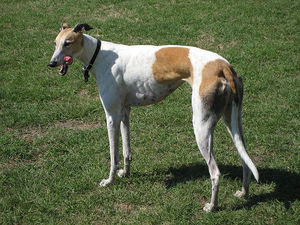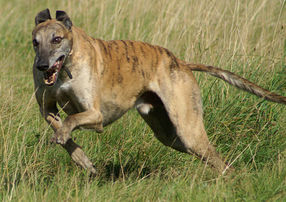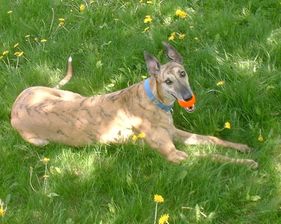Greyhound

Other names:
English greyhound
Country of origin:
Weight
Male:
27 to 40 kilograms (60 to 88 lb)
Female:
27 to 34 kilograms (60 to 75 lb)
Height
Male:
71 to 76 centimetres (28 to 30 in)
Female:
68 to 71 centimetres (27 to 28 in)
Coat:
Fine, smooth
Litter size:
6-8 pups
Life span:
12-15 years
The greyhound is a breed of hunting dog that has been primarily bred for coursing game and racing, but with a recent resurgence of popularity increasingly as a pedigree show dog and family pet. It is a soft and intelligent breed that often becomes attached to its owners. It is the fastest breed of dog. A combination of long, powerful legs, deep chest, flexible spine and slim build allow it to reach sprint speeds of circa 17meters per second/circa 61kmh.
Description
Appearance
Males are usually 71 to 76 centimetres (28 to 30 in) tall at the withers and weigh around 27 to 40 kilograms (60 to 88 lb). Females tend to be smaller with shoulder heights ranging from 68 to 71 centimetres (27 to 28 in) and weights from less than 27 to 34 kilograms (60 to 75 lb). Greyhounds have very short hair, which is easy to maintain. There are approximately thirty recognized color forms, of which variations of white, brindle, fawn, black, red and blue (gray) can appear uniquely or in combination.
Anatomy
The key to the speed of a greyhound can be found in its light but muscular build, largest heart, and highest percentage of fast-twitch muscle of any breed, the double suspension gallop and the extreme flexibility of the spine. "Double suspension rotary gallop" describes the fastest running gait of the greyhound in which all four feet are free from the ground in two phases, contracted and extended, during each full stride.
Temperament
Although greyhounds are extremely fast and athletic, and despite their reputation as racing dogs, they are not high-energy dogs. They are sprinters, and although they love running, they do not require extensive exercise. Most are quiet, gentle animals. An adult greyhound will stay healthy and happy with a daily walk of as little as 20 to 30 minutes. Greyhounds have been referred to as "Forty-five mile per hour couch potatoes."
Roles
Racing
Until the early twentieth century, greyhounds were principally bred and trained for coursing. During the early 1920s, modern Greyhound racing was introduced into the United States and introduced into The United Kingdom (Belle Vue) in 1936 and Northern Ireland (Celtic Park) on April 18, 1927 and immediately followed by Shelbourne Park in Dublin very soon after. The greyhound holds the record for fastest recorded dog.
Aside from professional racing, many greyhounds enjoy success on the amateur race track. Organizations like the Large Gazehound Racing Association (LGRA) and the National Oval Track Racing Association (NOTRA) provide opportunities for greyhounds and other sighthound breeds to compete in amateur racing events all over the United States.
Coursing
The original function of greyhounds, both in the British Isles and on the Continent of Europe was in the coursing of deer, much later they specialised as competition hare coursing dogs. Some greyhounds still fulfill their live coursing function, although artificial lure sports like lure coursing and racing are far more common and popular.
Both the American Kennel Club and the American Sighthound Field Association sponsor lure coursing events in North America.
Greyhounds as pets

A male brindle greyhound
Greyhound owners and adoption groups generally consider greyhounds to be wonderful pets. They are pack-oriented dogs, which means that they will quickly adopt humans into their pack as alpha. They can get along well with children, dogs and other family pets. Rescued racing greyhounds occasionally develop separation anxiety when re-housed or when their new owners have to leave them alone for a period of time (the addition of a second greyhound often solves this problem).
Greyhounds bark very little, which helps in suburban environments, and are usually as friendly to strangers as they are with their own family. The most common misconception concerning greyhounds is that they are hyperactive. In retired racing greyhounds it is usually the opposite. Young greyhounds that have never been taught how to utilize the energy they are bred with, can be hyperactive and destructive if not given an outlet, and require more experienced handlers. Rescued Greyhounds, however, have been taught to chase after small, furry things, and may be confused or need guidance on how to deal with small animals such as kittens, rabbits, and other small furry objects.
Greyhound adoption groups generally require owners to keep their greyhounds on-leash at all times, except in fully enclosed areas. This is due to their prey-drive, their speed, and the assertion that greyhounds have no road sense. Due to their strength, adoption groups recommend that fences be between 4 and 6 feet, to prevent them being able to jump.
Greyhounds do shed but do not have undercoats and therefore are less likely to trigger people's dog allergies (they are sometimes incorrectly referred to as "hypoallergenic"). The lack of an undercoat, coupled with a general lack of body fat, also makes greyhounds more susceptible to extreme temperatures, and most sources recommend that greyhounds be housed inside.
Greyhounds are very sensitive to insecticides. Many vets do not recommend the use of flea collars or flea spray on greyhounds unless it is a pyrethrin-based product. Products like Advantage, Frontline, Lufenuron, and Amitraz are safe for use on greyhounds and are very effective in controlling fleas and ticks.
It is often believed that greyhounds need a large living space, however, they can thrive in small spaces. Due to their temperament, greyhounds can make better "apartment dogs" than some of the smaller hyperactive breeds.
Greyhounds bark very little, which helps in suburban environments, and are usually as friendly to strangers as they are with their own family. The most common misconception concerning greyhounds is that they are hyperactive. In retired racing greyhounds it is usually the opposite. Young greyhounds that have never been taught how to utilize the energy they are bred with, can be hyperactive and destructive if not given an outlet, and require more experienced handlers. Rescued Greyhounds, however, have been taught to chase after small, furry things, and may be confused or need guidance on how to deal with small animals such as kittens, rabbits, and other small furry objects.
Greyhound adoption groups generally require owners to keep their greyhounds on-leash at all times, except in fully enclosed areas. This is due to their prey-drive, their speed, and the assertion that greyhounds have no road sense. Due to their strength, adoption groups recommend that fences be between 4 and 6 feet, to prevent them being able to jump.
Greyhounds do shed but do not have undercoats and therefore are less likely to trigger people's dog allergies (they are sometimes incorrectly referred to as "hypoallergenic"). The lack of an undercoat, coupled with a general lack of body fat, also makes greyhounds more susceptible to extreme temperatures, and most sources recommend that greyhounds be housed inside.
Greyhounds are very sensitive to insecticides. Many vets do not recommend the use of flea collars or flea spray on greyhounds unless it is a pyrethrin-based product. Products like Advantage, Frontline, Lufenuron, and Amitraz are safe for use on greyhounds and are very effective in controlling fleas and ticks.
It is often believed that greyhounds need a large living space, however, they can thrive in small spaces. Due to their temperament, greyhounds can make better "apartment dogs" than some of the smaller hyperactive breeds.
Health and Physiology

An adopted Greyhound, 5 years old
Greyhounds are typically a healthy and long-lived breed, and hereditary illness is rare. Some greyhounds have been known to develop esophageal achalasia, bloat (gastric torsion), and osteosarcoma. Because the greyhound's lean physique makes it ill-suited to sleeping on hard surfaces, owners of companion greyhounds generally provide soft bedding; without bedding, greyhounds are prone to develop painful skin sores. The typical greyhound lifespan is 10 to 13 years.
Due to the unique physiology and anatomy of greyhounds, a veterinarian who understands the issues relevant to the breed is generally needed when the dogs need treatment, particularly when anaesthesia is required. Greyhounds cannot metabolize barbiturate-based anesthesia as other breeds can because they have lower amounts of oxidative enzymes in their livers. Greyhounds demonstrate unusual blood chemistry, which can be misread by veterinarians not familiar with the breed; this can result in an incorrect diagnosis.
Greyhounds have higher levels of red blood cells than other breeds. Since red blood cells carry oxygen to the muscles, this higher level allows the hound to move larger quantities of oxygen faster from the lungs to the muscles. Greyhounds have lower levels of platelets than other breeds. Veterinary blood services often use greyhounds as universal blood donors.
History
The breed's origin is romantically reputed to be connected to ancient Egypt, where depictions of smooth-coated sighthound types have been found which are typical of Saluki (Persian Greyhound) or Sloughi (tombs at Beni Hassan circa 2000BC). However, analyses of DNA reported in 2004 suggest that the Greyhound is not closely related to these Oriental breeds, but is a close relative to herding dogs. Historical literature on the first sighthound in Europe (Arrian), the vertragus, the probable antecedent of the Greyhound, suggests that the origin is with the ancient Celts from Eastern Europe or Eurasia. All modern, purebred pedigree Greyhounds, are derived from the greyhound stock recorded and registered, firstly in the private 18th century then public 19th century studbooks, which ultimately were registered with Coursing, Racing, and Kennel Club authorities of the United Kingdom.
Historically, these sighthounds were used primarily for hunting in the open where their keen eyesight is valuable. It is believed that they (or at least similarly-named dogs) were introduced to the area now known as the United Kingdom in the 5th and 6th century BC from Celtic mainland Europe although the Picts and other hunter gatherer tribes of the Northern area (now known as Scotland) were believed to have had large hounds similar to that of the Deerhound before the 6th century BC.
The name "greyhound" is generally believed to come from the Old English grighund. "Hund" is the antecedent of the modern "hound", but the meaning of "grig" is undetermined, other than in reference to dogs in Old English and Norse. Its origin does not appear to have any common root with the modern word "grey" for color, and indeed the greyhound is seen with a wide variety of coat colors. It is known that in England during the medieval period, lords and royalty keen to own greyhounds for sport, requested they be bred to color variants that made them easier to view and identify in pursuit of their quarry. The lighter colors, patch-like markings and white appeared in the breed that was once ordinarily grey in color. The greyhound is the only dog mentioned by name in the Bible; the King James version names the Greyhound as one of the four things stately in the Proverbs. However, in the modern version of the Bible this has been changed to strutting rooster, which appears to be a more correct translation of the Hebrew term זַרְזִיר (zarzir).
According to Pokorny the English name "greyhound" does not mean "gray dog/hound", but simply "fair dog". Subsequent words have been derived from the Proto-Indo-European root *g'her- 'shine, twinkle': English gray, Old High German gris 'grey, old', Old Icelandic griss 'piglet, pig', Old Icelandic gryja 'to dawn', gryjandi 'morning twilight', Old Irish grian 'sun', Old Church Slavonic zorja 'morning twilight, brightness'. The common sense of these words is 'to shine; bright'.
Due to the unique physiology and anatomy of greyhounds, a veterinarian who understands the issues relevant to the breed is generally needed when the dogs need treatment, particularly when anaesthesia is required. Greyhounds cannot metabolize barbiturate-based anesthesia as other breeds can because they have lower amounts of oxidative enzymes in their livers. Greyhounds demonstrate unusual blood chemistry, which can be misread by veterinarians not familiar with the breed; this can result in an incorrect diagnosis.
Greyhounds have higher levels of red blood cells than other breeds. Since red blood cells carry oxygen to the muscles, this higher level allows the hound to move larger quantities of oxygen faster from the lungs to the muscles. Greyhounds have lower levels of platelets than other breeds. Veterinary blood services often use greyhounds as universal blood donors.
History
The breed's origin is romantically reputed to be connected to ancient Egypt, where depictions of smooth-coated sighthound types have been found which are typical of Saluki (Persian Greyhound) or Sloughi (tombs at Beni Hassan circa 2000BC). However, analyses of DNA reported in 2004 suggest that the Greyhound is not closely related to these Oriental breeds, but is a close relative to herding dogs. Historical literature on the first sighthound in Europe (Arrian), the vertragus, the probable antecedent of the Greyhound, suggests that the origin is with the ancient Celts from Eastern Europe or Eurasia. All modern, purebred pedigree Greyhounds, are derived from the greyhound stock recorded and registered, firstly in the private 18th century then public 19th century studbooks, which ultimately were registered with Coursing, Racing, and Kennel Club authorities of the United Kingdom.
Historically, these sighthounds were used primarily for hunting in the open where their keen eyesight is valuable. It is believed that they (or at least similarly-named dogs) were introduced to the area now known as the United Kingdom in the 5th and 6th century BC from Celtic mainland Europe although the Picts and other hunter gatherer tribes of the Northern area (now known as Scotland) were believed to have had large hounds similar to that of the Deerhound before the 6th century BC.
The name "greyhound" is generally believed to come from the Old English grighund. "Hund" is the antecedent of the modern "hound", but the meaning of "grig" is undetermined, other than in reference to dogs in Old English and Norse. Its origin does not appear to have any common root with the modern word "grey" for color, and indeed the greyhound is seen with a wide variety of coat colors. It is known that in England during the medieval period, lords and royalty keen to own greyhounds for sport, requested they be bred to color variants that made them easier to view and identify in pursuit of their quarry. The lighter colors, patch-like markings and white appeared in the breed that was once ordinarily grey in color. The greyhound is the only dog mentioned by name in the Bible; the King James version names the Greyhound as one of the four things stately in the Proverbs. However, in the modern version of the Bible this has been changed to strutting rooster, which appears to be a more correct translation of the Hebrew term זַרְזִיר (zarzir).
According to Pokorny the English name "greyhound" does not mean "gray dog/hound", but simply "fair dog". Subsequent words have been derived from the Proto-Indo-European root *g'her- 'shine, twinkle': English gray, Old High German gris 'grey, old', Old Icelandic griss 'piglet, pig', Old Icelandic gryja 'to dawn', gryjandi 'morning twilight', Old Irish grian 'sun', Old Church Slavonic zorja 'morning twilight, brightness'. The common sense of these words is 'to shine; bright'.
